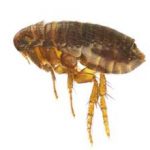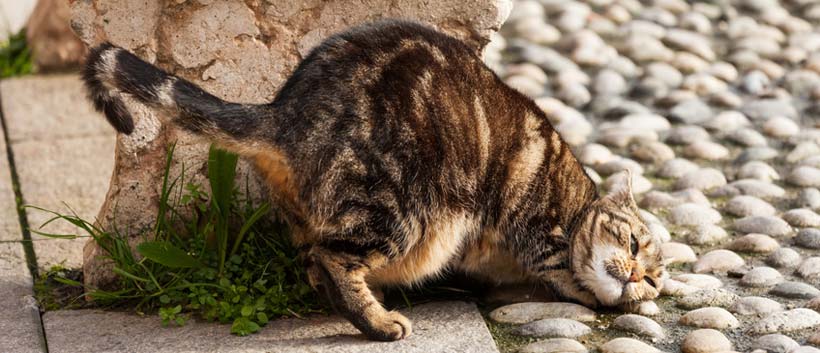Flea is the common name for any of the small wingless insects of the order Siphonaptera. Fleas are external parasites, living by hematophagy off the blood of mammals and birds, which are also flightless. In the past, however, it was most commonly supposed that fleas had evolved from the flies, based on similarities of the larvae.

Fleas pass through a complete life cycle consisting of egg, larva, pupa and adult. Completion of the life cycle from egg to adult varies from two weeks to eight months depending on the temperature, humidity, food, and species. Normally after a blood meal, the female flea lays about 15 to 20 eggs per day — up to 600 in its lifetime — usually on the host (dogs, cats, rats, rabbits, mice, squirrels, chipmunks, raccoons, opossums, foxes, chickens, humans, etc.). Eggs loosely laid in the hair coat drop out almost anywhere, especially where the host rests, sleeps or nests (rugs, carpets, upholstered furniture, cat or dog boxes, kennels, sand boxes, etc.). Eggs hatch between two days to two weeks into larvae found indoors in and along floor cracks, crevices, along baseboards, under rug edges and in furniture or beds. Outdoor development occurs in sandy gravel soils (moist sand boxes, dirt crawlspace under the house, under shrubs, etc.) where the host may rest or sleep. Sand and gravel are very suitable for larval development which is the reason fleas are erroneously called “sand fleas.”

Larvae are blind, avoid light, pass through three larval instars and take a week to several months to develop. Their food consists of digested blood from adult flea feces, dead skin, hair, feathers, and other organic debris; larvae do not suck blood. Pupae mature to adulthood within a silken cocoon woven by the larva to which pet hair, carpet fiber, dust, grass cuttings, and other debris adheres. In about five to fourteen days, adult fleas emerge or may remain resting in the cocoon until the detection of vibration (pet and people movement), pressure (host animal lying down on them), heat, noise, or carbon dioxide (meaning a potential blood source is near). Most fleas overwinter in the larval or pupal stage with survival and growth best during warm, moist winters and spring.
“Flea season” is traditionally at the end of summer and in the early fall, but in warmer areas can last year round.
more information on Wikipedia: Fleas
How do they enter the house?
Fleas can enter the home in many ways, even if your pet is not or only rarely allowed outside. They can hop in from your yard, hitch a ride on you, or even be left over from previous inhabitants (larvae can remain dormant for astonishingly long periods of time under a variety of conditions).
Why should I worry about fleas?
Since fleas can be carriers for worms and diseases, keeping your pet flea-free helps to keep it healthy. In addition, many pets and people are allergic to flea-bites.
How can I tell if my pet has fleas?
To check if your pet has fleas, part its hair and look for:
- Small bits of brown “dust,” attached to the fur itself. The fleas excrete digested blood. See if the dust dissolves into a red liquid upon contact with a wet paper towel.
- Skin Irritation: flea bites or scratching and biting may leave red, irritated skin, and even bald patches in bad cases.
- Small, fast moving brown shapes are fleas.
- Or, use a flea comb and see what you get.You may also see “flea dust,” fleas, or even larvae on your pet’s bedding.
- Dried blood in its ears may indicate ear mites and you should consult your vet to find out what the problem is.
Preventive measures
Conventional wisdom and older studies that studied rat fleas suggest that fleas spend only part of their time on your pet; this is not true. There are different varieties of fleas, and the primary flea infesting dogs and cats in North America and large areas of Europeis the cat flea (yes on dogs, too). This flee, not as well studied as the rat flea actually spends all of its adult life on the host under normal conditions. Eggs are laid on the host and drop off into the environment. Thus you can often find eggs wherever your pets spend time: on their bedding, through the house, in the backyard.
A good preventive method is to put down towels everywhere your pet normally lies and then wash those towels once a week. Deposited flea eggs are therefore cleaned out regularly. Regular vacuuming and emptying of the vacuum bag also helps, independently of any method or methods you choose to do, since that eliminates or reduces food sources for the larvae.
How to choose your methods
There are several ways to kill or discourage fleas. Some are synthetic chemicals, some are considered “natural”, and both work with varying degrees. No one method is 100% effective, and you will almost always have to combine several approaches to get the results you want. Some methods are applicable for indoor pets, but useless for indoor/outdoor pets. You need to choose the set of approaches that best addresses your situation.
Keep in mind that there are regional differences among fleas: what works well in one area may not work well in other areas. You should consult a LOCAL vet, vet tech, or dog groomer to see what is known to be effective in your area. If you think you’re getting biased opinions, ask several people and see what they concur on. Don’t rely on the products available at your local store; there are too many that are just distributed nationally.
Finally, you may find that you need to switch your approaches around from year to year. If you use the same product several years in a row, you may find the effectiveness lessened. Additionally, some years are worse than others, depending on the previous winter, and you may need to strike earlier with stronger methods some years and relax a bit more with milder methods another year.
What is the Lifecycle of fleas?
You must keep in mind the life cycle of the flea. From egg to larvae to adult is between three to six weeks: to get rid of fleas in your house, you must break this cycle. As a practical matter, this means you will almost certainly have to repeat your efforts in several weeks to catch the fleas from the larvae that didn’t get destroyed the first time around. This is also why it is important to address the problem of the eggs and larvae as well as the adult fleas.
After taking a blood meal, fleas either lay eggs on your pet or in its surrounding environment. Eggs on your pet are often shed onto its bedding or into the carpet. A pair of fleas may produce 20,000 fleas in 3 months. Eggs hatch after 2-12 days into larvae that feed in the environment — generally on digested blood from adult fleas and other food matter in their environment. The food required at this stage is microscopic, and even clean carpets often offer plenty of food to the larvae. The larvae are little wiggles about 3-4 millimeters long, you may see some if you inspect your pet’s bedding carefully. Larvae molt twice within 2-200 days and the older larvae spin a cocoon in which they remain for one week to one year. When in this cocoon stage the young flea is invulnerable to any kind of insecticide and to low, even freezing, temperatures. Only sufficient warmth and the presence of a host can cause them to emerge. This long cocooning period explains why fleas are so difficult to eradicate.
Is necessary to comb my pet?
Flea combs with fine teeth that snag fleas are commercially available. It is helpful to have a small dish of ammonia-laced water on hand to kill the fleas on the comb rather than trying to nail each one by hand. Alternatively, mix a few drops of detergent into the dish of water so that there is no surface tension and fleas dropped into the treated water will drown. Use a metal comb; the plastic ones are too flexible and allow the fleas to escape.
You will typically find the most fleas along your pet’s back, groin area, and at the base of the tail.
This by itself will never rid your pet from fleas since flea larvae may also be in bedding, furniture and carpet. It is, however, a useful way to keep an eye on the flea population, and if used as a preventive measure can keep them in check. If you have a major infestation, though, you will have to get rid of most of the fleas before you can use just a comb on your pet.
What about the Flea collars?
Flea collars aren’t effective and may even be bad for your pet’s health. Some of the herbal ones smell nice and that’s about it.
Ultrasonic and electronic flea collars are not known to work.
We know that Catandog’s works and has a 95% effectivennes.
